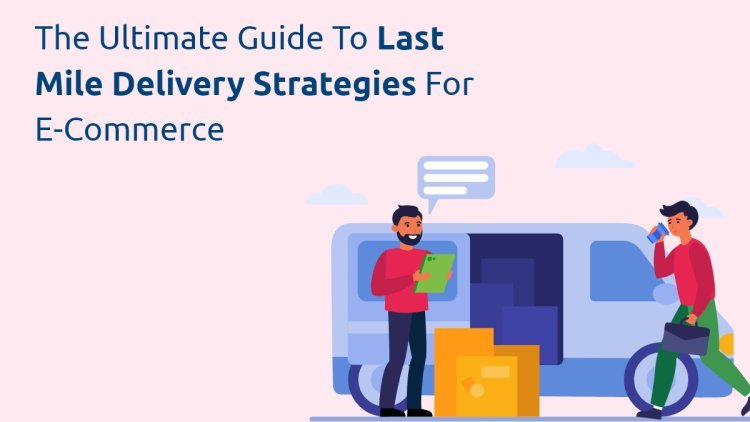The Ultimate Guide to Last Mile Delivery Strategies for E-commerce
This comprehensive guide explores essential tactics for optimizing last mile delivery in e-commerce. It covers real-time tracking, route optimization, innovative delivery methods, and seamless integration strategies to enhance efficiency, reduce costs, and boost customer satisfaction.

In the rapidly evolving world of e-commerce, last mile delivery has emerged as a critical component of the customer experience. It represents the final step in the supply chain, where goods are transported from a distribution center to the customer’s doorstep. As consumer expectations for fast, reliable, and transparent delivery continue to rise, developing effective last mile delivery strategies is essential for e-commerce businesses aiming to stay competitive and ensure customer satisfaction. This guide provides an in-depth look at key strategies for optimizing last mile delivery in e-commerce.
Understanding the Importance of Last Mile Delivery
Last mile delivery is often the most complex and costly part of the supply chain. It’s where the efficiency of logistics directly impacts customer satisfaction and business profitability. In fact, a smooth and reliable last mile grocery delivery can significantly enhance customer loyalty, while delays or issues can lead to negative reviews and lost sales. Therefore, investing in effective last mile delivery strategies is crucial for maintaining a competitive edge in the e-commerce sector.
1. Embrace Technology and Automation
Technology plays a pivotal role in optimizing last mile delivery. Leveraging advanced tools such as route optimization software, real-time tracking systems, and automated dispatching can streamline operations and improve efficiency. Route optimization software helps in planning the most efficient delivery routes, taking into account real-time traffic conditions and delivery windows. This not only reduces delivery times but also lowers fuel costs and vehicle wear and tear.
Real-time tracking systems enhance transparency by allowing customers to monitor their orders in real time. Automated dispatching tools can help manage delivery schedules and allocate resources effectively, reducing human error and improving overall service efficiency. Embracing these technologies can lead to significant improvements in delivery performance and customer satisfaction.
2. Offer Flexible Delivery Options
Flexibility in delivery options is increasingly important for meeting diverse customer preferences. Offering multiple delivery options, such as same-day delivery, next-day delivery, and scheduled delivery, allows customers to choose the service that best fits their needs. Additionally, providing options for delivery time slots and locations, such as delivery to a nearby pickup point or locker, can enhance convenience and customer satisfaction.
Implementing a range of delivery options can also help manage peak periods and balance delivery loads. For example, during high-demand seasons, such as holidays or sales events, offering expedited delivery options can help meet increased customer expectations while optimizing delivery capacity.
3. Leverage Local Partnerships and Crowdsourcing
Collaborating with local delivery partners and leveraging crowdsourcing can improve the efficiency and reach of your last mile delivery operations. Local delivery partners, such as regional courier services and independent delivery providers, can offer valuable insights into local traffic patterns and customer preferences. They can also help handle deliveries in areas that may be challenging for larger logistics providers.
Crowdsourcing, through platforms that connect businesses with independent drivers or delivery personnel, can provide additional flexibility and scalability. This approach allows you to quickly adapt to changes in demand and expand your delivery network without the need for significant investments in fleet management.
4. Enhance Customer Communication
Effective communication is key to a successful last mile delivery strategy. Keeping customers informed throughout the delivery process helps manage their expectations and enhances their overall experience. Automated notifications, such as order confirmations, delivery updates, and estimated arrival times, can provide customers with timely and relevant information.
Offering multiple communication channels, such as email, SMS, and mobile apps, allows customers to choose their preferred method of receiving updates. Additionally, providing a platform for customers to track their orders in real time can reduce uncertainty and improve satisfaction.
5. Focus on Sustainability
Sustainability is becoming increasingly important in e-commerce, and last mile delivery is no exception. Implementing environmentally friendly practices can not only reduce your carbon footprint but also appeal to environmentally conscious consumers. Consider options such as using electric or hybrid vehicles, optimizing routes to reduce fuel consumption, and implementing eco-friendly packaging.
Promoting sustainable delivery practices can enhance your brand’s reputation and differentiate your business in a competitive market. Communicating your commitment to sustainability can also strengthen customer loyalty and attract new customers who value eco-friendly practices.
6. Continuously Monitor and Optimize
Continuous monitoring and optimization are essential for maintaining an effective last mile delivery strategy. Regularly review key performance indicators (KPIs) such as delivery times, customer feedback, and operational costs to identify areas for improvement. Use data analytics to gain insights into delivery performance and customer preferences, allowing you to make informed decisions and adjustments.
Investing in ongoing training for your delivery team and staying updated on industry trends and technologies can also help you stay ahead of the competition and continually enhance your delivery operations.
Conclusion
In the competitive world of e-commerce, mastering last mile delivery is crucial for achieving customer satisfaction and business success. By embracing technology, offering flexible delivery options, leveraging local partnerships, enhancing communication, focusing on sustainability, and continuously monitoring performance, you can develop a robust last mile delivery strategy that meets customer expectations and drives growth. As consumer demands evolve, staying agile and responsive in your delivery operations will ensure you remain competitive and deliver exceptional service to your customers.
What's Your Reaction?















